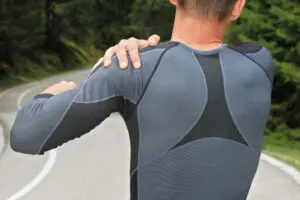A shoulder separation, or dislocation, occurs when the upper arm bone pops out of the cup-shaped socket that’s part of your shoulder blade. This tends to be common since the shoulder joint is one of the most unstable joints in our body. If you or someone you love is going through a dislocated shoulder recovery, here’s what you should know.
A Dislocated Shoulder And Why It’s So Common
A shoulder dislocation is a common occurrence because this joint can move in multiple directions. It happens if you fall on your shoulder or someone hits you with force. The upper arm or humerus bone can pop out of its socket since it is only attached by muscles and tendons. It can dislocate forward, backward, or downward, and you can experience a total or partial dislocation.
It happens frequently playing contact sports like hockey and football, as well as skiing and gymnastics where participants are likely to fall. Even falling off a bike and using your arms/hands to stop the fall can result in a shoulder dislocation.
Symptoms And What To Do
Intense pain, swelling, numbness, deformity, and spasms which can make the pain more severe are all symptoms of a shoulder separation. Don’t wait to seek care from Dr. Samuel Koo in Seattle, WA or the emergency room.
Your shoulder needs to be reset as soon as possible. This is known as a closed reduction. The longer you wait, it will become more difficult due to additional swelling. The reset will only take a few minutes, but you should know that recovery will take significantly longer.
Recovery From A Dislocated Shoulder
The process of recovery from a dislocated shoulder typically takes one to three months.
It includes the following steps:
Immobilize The Shoulder
You will need to keep your shoulder in place usually with a sling or splint for up to three weeks.
Pain Management and Medications
Ice can be applied several times a day to reduce any remaining mild pain or swelling, and pain medications may be prescribed. Over-the-counter anti-inflammatory medications are another option as your shoulder heals.
Rehabilitation
Once the splint is removed Dr. Samuel Koo may refer you to a physical therapist or provide exercises for you to perform at home. This is an important step to restore range of motion, strengthen your shoulder, and prevent another dislocation. Don’t rush your recovery or you will be more prone to recurrent dislocations.
Surgery can be an option if you have recurring dislocations.
Always be certain about when you can return to normal activities including sports.
Contact shoulder surgeon Samuel Koo, MD at (425) 823-4000 if you suspect you have a dislocated shoulder or if you have questions about your recovery process.




